
Parmaturus is a genus of catsharks in the family Scyliorhinidae. Four species were described in 2007 and another in 2019 with more species likely to be described in the near future.

McMillan's catshark is a catshark of the family Scyliorhinidae, in the order Carcharhiniformes. McMillan's catshark is a small, rare, and little-known deepwater shark that is endemic to New Zealand. It is found at depths of 985–1350m on the lower continental slope around New Zealand, on the West Norfolk Ridge, and off North Cape. It can grow to a length of 45 cm.

The lollipop catshark is a little-known species of deep sea catshark, belonging to the family Scyliorhinidae, and the only described member of its genus. A diminutive, bottom-dwelling shark of the outer continental shelf and upper continental slope, this species can be readily identified by its tadpole-like shape with a greatly expanded, rounded head and narrow body. The large head houses expanded gills, which are thought to be an adaptation for hypoxic conditions. This shark preys on crustaceans and fishes. Reproduction is aplacental viviparous, with females retaining egg cases internally two at a time until they hatch. There is no fishery interest in this species.

The Campeche catshark is a catshark of the family Schyliorhinidae. It is known only from the holotype, a 15.7 cm immature female found in the northwestern Bay of Campeche in the Gulf of Mexico. The specimen was collected at 1,057 m, a depth beyond current and probably future fishing pressure in the region. The reproduction of this catshark is oviparous.
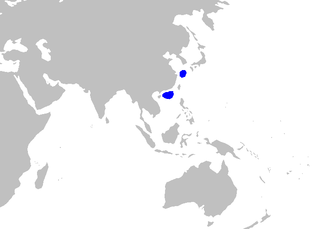
The blackgill catshark is a deep water catshark known from very few specimens, found on or near the bottom on the continental slope, at 540–835 metres (1,772–2,740 ft) off the coasts of China and Japan. Specimens can attain a total length of at least 85 cm (33 in), have elongated cat-like eyes, and have two small dorsal fins set far back. They’re oviparous and lay one egg at a time. This shark is a potential bycatch of deep water bottom-trawl fisheries operating within its range, but no specific information is available. In the upper jaw, there are rods of blunt, flat teeth with 3 cusps, likely used for crushing, as well as row of sharper teeth with the mid, central cusp longer and to a point. The bottom teeth are sharp, pointed, jagged and have three cusps, with the middle cusp slightly longer than the surrounding two.
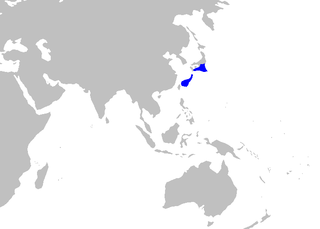
The salamander shark or salamander catshark is a little known catshark that inhabits a range from Japan and the East China Sea, on the upper to middle continental slope at depths of 358–895 m. Specimens of this species can attain a total length of at least 64 cm. This catshark is a potential bycatch of trawl fisheries operating within its range, but no details are available. There are high levels of squalene in this catshark's liver. The reproduction of this catshark is oviparous.

The narrowtail catshark is a catshark of the family Scyliorhinidae, found off the coasts of Honduras and Nicaragua, between latitudes 18° N and 10° N, at depths between 190 and 410 m. It can grow up to a length of 35 cm (14 in). The reproduction of this catshark is oviparous.

The quagga catshark is a species of catshark, belonging to the family Scyliorhinidae. A small, slim-bodied shark reaching 37 cm (15 in) in length, it has a distinctive color pattern of narrow, dark brown vertical bars, which resemble those of the quagga. Its head is short and flattened, with a pointed snout tip that is not upturned.

The Comoro catshark is a rare catshark of the family Scyliorhinidae. The holotype and only specimen was taken from the Comoros Islands in the Indian Ocean, at a depth of 400 metres (1,300 ft). The Comoro catshark is not well-documented. The reproduction of this catshark is oviparous.

The yellowspotted catshark is a rare catshark of the family Scyliorhinidae. It is found in the southeast Atlantic, from Lüderitz, Namibia to central Natal, South Africa, between latitudes 0° and 37° S. It can grow up to a length of about 1.22 metres. The reproduction of this catshark is oviparous.
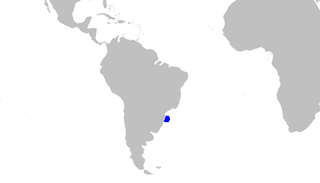
The southern sawtail catshark is a species of catshark, part of the family Scyliorhinidae, endemic to southern Brazil. It inhabits deepwater reefs on the upper continental slope at a depth of 236–600 m (774–1,969 ft). Reaching at least 43 cm (17 in) in length, this slim-bodied species closely resembles the Antilles catshark. It has a prominent crest of enlarged dermal denticles along the dorsal edge of the caudal fin, as well as a distinctive color pattern of dark oval blotches, outlined in white, along its back. The southern sawtail catshark is oviparous, with females producing reddish egg capsules. The International Union for Conservation of Nature (IUCN) has assessed it as Vulnerable; it is often taken as bycatch and may be threatened by intensifying squid fishing.

The dwarf sawtail catshark is a little-known species of catshark, belonging to the family Scyliorhinidae, found exclusively in the deep waters off Luzon in the Philippines. Unlike other members of its genus, this slender, diminutive shark has a short, rounded snout and very short furrows at the corners of its jaws. It has indistinct darker saddles beneath each dorsal fin and two dark bands on the caudal fin, as well as a prominent crest of enlarged dermal denticles along the upper caudal fin margin.
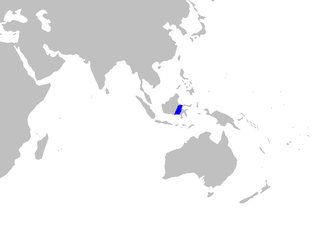
The pale catshark is a rare catshark of the family Scyliorhinidae. The holotype, the only specimen, was found on the Makassar Strait slope at a depth of 655 m. Its length is around 21 cm, although this measurement was taken from a juvenile specimen. The reproduction of the pale catshark is oviparous.

The dwarf lanternshark is a species of dogfish shark in the family Etmopteridae and is the smallest shark in the world, reaching a maximum known length of 20 cm (8 in). It is known to be present only on the upper continental slopes off Colombia and Venezuela, at a depth of 283–439 m (928–1,440 ft). This species can be identified by its small size at maturity, long flattened head, and pattern of black ventral markings and a mid-dorsal line. Like other members of its genus, it is capable of producing light from a distinctive array of photophores. Reproduction is aplacental viviparous, with females gestating two or three young at a time. The dwarf lanternshark is not significant to commercial fisheries, but could be threatened by mortality from bycatch; the degree of impact from human activities on its population is unknown.
The beige catshark is a cat shark of the family Scyliorhinidae, The first recorded specimen was a female recorded off the coast of Queensland, Australia around Lord Howe Island. Its length was 72 cm.
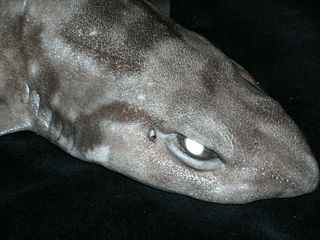
Scyliorhinus meadi, the blotched catshark, is a little-known species of catshark, and part of the family Scyliorhinidae, found in the western central Atlantic Ocean. It inhabits banks of deep-sea coral at depths of 329–548 m (1,079–1,798 ft), feeding on cephalopods, shrimp, and bony fishes. This species can be identified by its wide body and head, and the dark saddle-like markings on its back. It also has small spots that fluoresce yellow under a blue light. Adult blotched catsharks have not been observed; the largest immature specimen is 49 cm (19 in) long. Like other catsharks, it is believed to be oviparous. This species is not dangerous to humans and has no commercial significance.
The white-tip catshark is a recently described, deepwater catshark, known only from a single specimen collected from northern New Caledonia, at a depth of 590–732 m. The only known specimen, an adult male, measured a total of 57.7 cm in length. These sharks have spiracles, which are respiratory openings behind the eyes. Catsharks, all in all, are likewise recognized by two little dorsal fins. Numerous individuals from this group of sharks are likewise called dogfish.
The white-clasper catshark is a recently described deepwater catshark, known only from a single specimen collected from northern New Caledonia at a depth of 688–732 m. The only known specimen, an adult male, measured a total of 41.5 cm in length.

The Brazilian filetail catshark is a species of catshark of the family Schyliorhinidae, found in southern Brazil. It lives on the continental slopes at the depths of 500–600 m (1,600–2,000 ft).

















